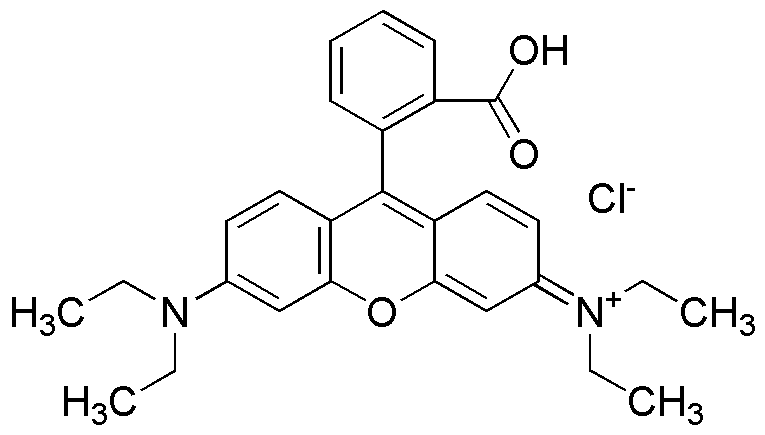Rhodamine B is widely utilized in research focused on:
- Fluorescent Dyes: Commonly used in microscopy and flow cytometry, Rhodamine B provides bright fluorescence, making it ideal for visualizing cellular structures and processes.
- Textile Industry: This compound serves as a dye for fabrics, offering vibrant colors and excellent lightfastness, which is crucial for maintaining the appearance of textiles over time.
- Biological Staining: In microbiology, it is employed for staining bacteria and other microorganisms, enhancing contrast in samples for better observation under a microscope.
- Environmental Monitoring: Used as a tracer dye in hydrology studies, Rhodamine B helps researchers track water flow and contamination in aquatic environments.
- Photodynamic Therapy: In medical applications, it shows potential in treating certain cancers by generating reactive oxygen species when exposed to light, targeting and destroying cancerous cells.
General Information
Properties
Safety and Regulations
Applications
Rhodamine B is widely utilized in research focused on:
- Fluorescent Dyes: Commonly used in microscopy and flow cytometry, Rhodamine B provides bright fluorescence, making it ideal for visualizing cellular structures and processes.
- Textile Industry: This compound serves as a dye for fabrics, offering vibrant colors and excellent lightfastness, which is crucial for maintaining the appearance of textiles over time.
- Biological Staining: In microbiology, it is employed for staining bacteria and other microorganisms, enhancing contrast in samples for better observation under a microscope.
- Environmental Monitoring: Used as a tracer dye in hydrology studies, Rhodamine B helps researchers track water flow and contamination in aquatic environments.
- Photodynamic Therapy: In medical applications, it shows potential in treating certain cancers by generating reactive oxygen species when exposed to light, targeting and destroying cancerous cells.
Documents
Safety Data Sheets (SDS)
The SDS provides comprehensive safety information on handling, storage, and disposal of the product.
Product Specification (PS)
The PS provides a comprehensive breakdown of the product’s properties, including chemical composition, physical state, purity, and storage requirements. It also details acceptable quality ranges and the product's intended applications.
Certificates of Analysis (COA)
Search for Certificates of Analysis (COA) by entering the products Lot Number. Lot and Batch Numbers can be found on a product’s label following the words ‘Lot’ or ‘Batch’.
*Catalog Number
*Lot Number
Certificates Of Origin (COO)
This COO confirms the country where the product was manufactured, and also details the materials and components used in it and whether it is derived from natural, synthetic, or other specific sources. This certificate may be required for customs, trade, and regulatory compliance.
*Catalog Number
*Lot Number
Safety Data Sheets (SDS)
The SDS provides comprehensive safety information on handling, storage, and disposal of the product.
DownloadProduct Specification (PS)
The PS provides a comprehensive breakdown of the product’s properties, including chemical composition, physical state, purity, and storage requirements. It also details acceptable quality ranges and the product's intended applications.
DownloadCertificates of Analysis (COA)
Search for Certificates of Analysis (COA) by entering the products Lot Number. Lot and Batch Numbers can be found on a product’s label following the words ‘Lot’ or ‘Batch’.
*Catalog Number
*Lot Number
Certificates Of Origin (COO)
This COO confirms the country where the product was manufactured, and also details the materials and components used in it and whether it is derived from natural, synthetic, or other specific sources. This certificate may be required for customs, trade, and regulatory compliance.


